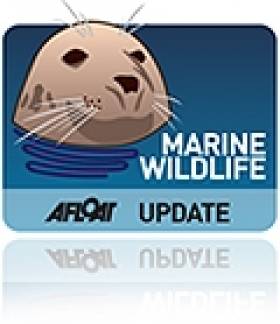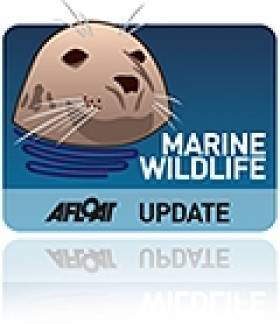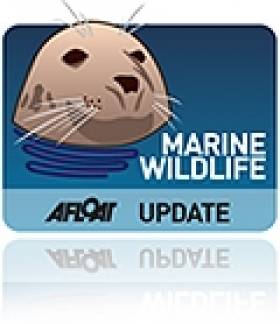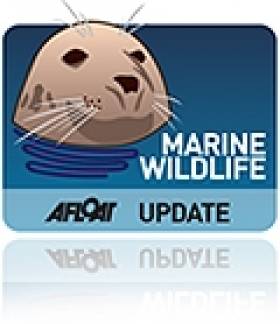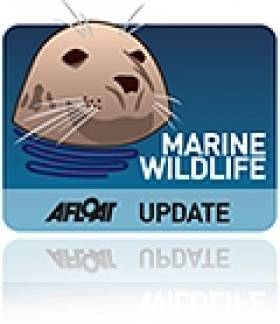Displaying items by tag: humpback whales
Cork Screening For Humpback Whale Film
#MarineWildlife - A new film on a decade-long study of humpback whales in the Atlantic will have a special screening in Cork later this month, as The Southern Star reports.
The Humpback Whales of Cape Verde – which stars some of the marine giants that visit Cape Clear every year – will be shown to the public in a free event at Clonakilty Library at 7.30pm on Wednesday 27 January.
It following the work of Dr Simon Berrow of GMIT the Irish Whale and Dolphin Group (IWDG), who has been a part of annual marine science expeditions to Cape Verde for a number of years, studying the humpback whales of the islands off Western Africa – and their connections with West Cork, where the species is regularly spotted each summer.
Dr Berrow also featured on Afloat.ie this week for the new journal paper he co-authored on the threat of banned toxic chemicals in European waters to killer whales and other cetaceans.
Note: a previous reference to a screening in North Donegal was inaccurate, but dates of future library tour screenings for the film from February 2016 can be found HERE.
Humpback Wows Whale Watchers With Breach Off Baltimore
#MarineWildlife - Whale Watch West Cork have shared this incredible video of one of a humpback whale breaching off Baltimore this week.
The whale is one of three of the ocean giants seen feeding off Baltimore and nearby islands in recent days, and caught in some stunning shots by photographer Simon Duggan, among others.
Meanwhile, some no less impressive sights have been seen of Donegal, new video shows basking sharks - the second biggest fish in the sea - breaching off Malin Head.
Bren Whelan of Wild Atlantic Way Climbing told Independent Travel that it's been an "outstanding week" for marine wildlife watching on the North Coast, saying he himself had witnessed "over 300" basking shark breaches.
Basking sharks have been seen in big numbers the area all month long, with 15 spotted during the Irish Whale and Dolphin Group's Whale Watch Ireland 2015 event on the afternoon of 23 August alone.
Secrets Of Ireland's Humpback Whales Revealed
#MarineWildlife - The mystery of where Ireland's humpback whales to go give birth remains – but two whales have been tracked between the Irish coast and feeding grounds in the Arctic for the first time.
That's the big news from a new research paper in the Journal of the Marine Biological Association of the United Kingdom, a collaborative effort between the Irish Whale and Dolphin Group (IWDG) and marine science colleagues in the United States, Iceland, Norway and the Netherlands.
According to co-author Dr Conor Ryan, the study reports on a comparison of the 28 humpback whales that have been photo IDed in Irish waters with a catalogue of over 8,000 such whales throughout the North Atlantic.
Ireland's "main stomping ground for humpbacks" was also examined in the paper, with a strong seasonal trend showing the whales appearing off the Kerry coast each summer – as tourists on the Wild Atlantic Way are becoming well aware.
IrishCentral reports on the latest BBC film shoot to capture the majestic marine mammals in their natural environment, before they move on to West Cork in autumn and further east to Waterford and Wexford as winter progresses – matching the movements of spawning sprat and herring shoals.
The IWDG website has much more on the story HERE.
Six Humpback Whales Surprise Small Sailboat
#MarineWildlife - The video above shows the shocking moment when a small boat of wildlife watchers was suddenly surrounded by six giant humpback whales.
As the Irish Mirror reports, the duo who captured this amazing footage were sailing in a Norwegian fjord when they saw the whales feeding on herring in the distance and decided to move closer for a better look.
But little did they imagine how close they would get!
Thankfully for the pair, their boat was barely rocked on the waves as the marine giants deftly manoeuvred around them.
"I felt very confident afterwards," said Svein Aasjord, one of the two sailors. "Whales have much more control than I had thought."
Although Irish whale watchers might not be treated to such sights in close quarters, the Northwest is currently a treat for anyone who wants to see minke whales in action.
The Irish Whale and Dolphin Group reports on what's become a trend for the species wintering off the Donegal coast between Bun on Inver and Bloody Foreland.
As many as six min whales were spotted in inshore waters within 200 metres the latter location three days ago, due most likely to the bounty of herring in the area.
BBC Crew Film Humpback Whale Off Skelligs
#MarineWildlife - Ireland is "one of the best locations on the northern hemisphere" to film marine wildlife in action, according to RTÉ News.
The statement comes from the Irish Whale and Dolphin Group's (IWDG) Pádraig Whooley, who recently returned from a trip off Kerry on board the organisation's research vessel Celtic Mist with a camera crew from the BBC's Natural History Unit.
Their mission, in planning for a year, was to film humpback whales – and by their second day on the water, past the Skelligs, they came upon heir first specimen, #HBIRL23, a "big-winged New Englander" who has been spotted around the Blaskets and Skelligs a number of times since May this year.
"Not only did we capture some magical moments with this animal in a stunning location, often breaching and fluking with the Skelligs in the background to our west, but this re-sighting is another important piece of information regarding the movements of humpback whales visiting the Irish Southwest," said Whooley, the IWDG's sightings officer.
What's more, the sighting last week was surely a good omen for yesterday's Whale Watch Ireland event across 20 mainland vantage points around Ireland's coast.
The IWDG website has much more on the story HERE.
Humpback Whales Liven Up NI's National Marine Week
#MarineWildlife - Northern Ireland's National Marine Week kicks off today (Saturday 26 July) with a 'rockpool ramble' at Groomsport in Co Down, the first in a series of marine wildlife themed events around the coast till 10 August.
Ulster Wildlife’s Living Seas staff and volunteers will be sharing their knowledge and expertise to help everyone find out more about the wonderfully varied wildlife found under our coastal waters, from tiny corals and shoals of gleaming fish, to playful seals and massive basking sharks, the world’s second largest fish.
“Many people see the sea simply as a huge expanse of water, but under the surface is a treasure trove of hidden gems, which we depend upon in so many ways," said Jade Berman, Living Seas manager with Ulster Wildlife.
“National Marine Week offers everyone the opportunity to find more to enjoy, more to learn and more to value in the fantastic marine life around our shores. Once they know what’s out there, we have no doubt that many more people will want to see our marine habitats and wildlife properly protected.”
One of the highlights this year is the Whale Workshop roadshow, which stops at Foyleside Shopping Centre for three days from tomorrow (Sunday 27 July) before moving to the Quays Shopping Centre in Newry from 1-4 August.
The Whale Workshop, which has toured internationally, lets the public get up close with life-size replicas of species such as dolphins, porpoise, seals, leatherback turtles, the aforementioned basking shark – and even a minke whale.
A complete list of events for National Marine Week can be found HERE – and if you're lucky, you might catch a glimpse of one of two humpback whales sighted off the Co Down coast in recent days.
According to the Belfast Telegraph, the first of these sightings last Sunday 20 July was only the fifth record of this species in the Irish Sea in 100 years.
A second spotting of that distinctive tail near the Copeland Islands was compared to the first by the Irish Whale and Dolphin Group's (IWDG) Padraig Whooley, who is "fairly confident" they are two different whales, according to his colleague Ian Enlander.
Whooley has much more in a detailed article on the IWDG website HERE.
Video: Courting Humpback Whales Duel Off Baltimore
#MarineWildlife - Check out this wonderful video - via the Baltimore Photos Facebook page - of two male humpback whales fighting over a prospective female partner off West Cork late last year.
Richard O'Flynn, who posted the footage to YouTube, says: "We were following two humpbacks for about 30 minutes when a third one turned up.
"What you're seeing here is the female to the right of the shot and her partner between her and the third humpback trying to keep him away from her. It went on for about one-and-a-half hours!"
O'Flynn said it was only his second time using the video camera "so please forgive the shake... and I was driving the boat at the same time!"
First Whales of 2013 Sighted Off Wexford
#MarineWildlife - The whale watching season is well under way off the coast of Wexford, as the Irish Whale and Dolphin Group (IWDG) reported its first sightings of 2013 this week.
Just an hour into the maiden cetacean spotting voyage of the IWDG's new research vessel Celtic Mist at the weekend, members of the group were treated to the sight of fin whales and minke whales feeding south of Hook Head - not to mention some of the 'superpod' of dolphins seen last week in the Irish Sea.
And as World Irish reports, local wildlife ranger Tony Murray spotted the first humpback whale of the year in the same area.
Murray suggested that "a large herring haul going on in the southeast at the moment" is the main attraction for the ocean giants and their smaller, more plentiful companions.
The IWDG's Facebook page has a photo gallery containing some stunning snapshots of the day's excursion HERE.
Humpback Sightings Brighten a Dreary Winter in Baltimore
#MarineWildlife - The Sunday Independent reports on the recent visits by humpback whales to Baltimore that have taken the West Cork village by storm.
"The familiar vocabularies of fishing and sailing, which normally permeate worthwhile conversation in the village, have been temporarily relegated," writes Louis Jacob.
"Bubble-netting, breaching, pectoral-slapping and tail-fluking are just a few of the terms driving the discourse in the village now."
The humpback pod was captured on video a fortnight ago feeding on "the abundance of Atlantic sprat" shoaling along the coast - and their arrival has "triggered an epidemic of humpback-mania in Baltimore", lighting a spark of life during the slow December weeks.
Jacob also spoke to local photographer Simon Duggan, who was lucky enough to capture some stunning images of the breaching whales - which has in turn aided the sightings records of the Irish Whale and Dolphin Group (IWDG).
Meanwhile, Niamh Naughton of veterinary X-ray firm BCF Technology was delighted to hand over a cheque for £2,000 (€2,480) on behalf of the BCF Foundation to Pádraig Whooley of the IWDG recently to support its cetacean conservation work.
Whooley commented: “We are so grateful for the support from BCF. This money will go into supporting us help people record sightings and strandings around the coastline of Ireland.
"Last year there were about 1,500 sightings of whales and dolphins in our waters.”
Humpback, Fin Whales Moving East Along Cork Coast Says IWDG
#MarineWildlife - The Irish Whale and Dolphin Group (IWDG) reports of another "frenzy of activity" while on a whale research cruise off West Cork this week.
The 'members only' trip on Wednesday 5 December took in the hotspot west of Reen Pier in Union Hall "where humpback and fin whales have enthralled hundreds of whale watchers and wildlife enthusiasts alike in recent weeks," according to IWDG sightings co-ordinator Pádraig Whooley.
When it soon became clear that most of the whales had left the area, the team headed east to return an ill member to shore.
"This turn of events proved almost karmic," says Whooley, "as not long after dropping our colleague back to Reen Pier, we started getting text messages from IWDG observers Tim Feen and Chris O'Sullivan of both humpback and fin whales well to the east on the Clonakilty Bay side of Galley Head."
Racing against the fading afternoon light, the boat made it to the scene to witness the blows first of fin whales, then humpbacks - at least five of the latter and seven of the former - and confirming them as the giants previously seen between the Kedge and Stags.
The team collected biopsy samples from most of the relaxed pod, including one that is suspected to be a female humpback with a calf.
"Since then, the weather has been very poor," says Whooley, "but there are still sufficient reports coming into IWDG to suggest to us that the large whale activity is slowly pushing east."
The IWDG is also collaborating with the BBC's WinterWatch programme next week, which is hoping to follow up on last year's AutumnWatch special on fin whales from East Cork and Waterford by filming humpback whales in West Cork.
Members of the public or whale-watchers are encouraged to report any sightings they might witness over the weekend to the IWDG by using the 'Report a sighting' link on the home page at iwdg.ie.



























